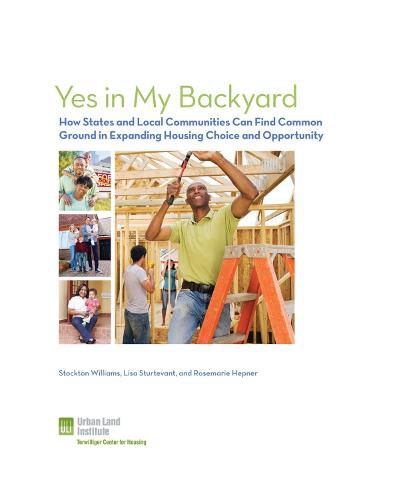Readings Newsletter
Become a Readings Member to make your shopping experience even easier.
Sign in or sign up for free!
You’re not far away from qualifying for FREE standard shipping within Australia
You’ve qualified for FREE standard shipping within Australia
The cart is loading…






State governments, in partnership with cities and other local jurisdictions, can and should do more to promote housing development and choice through smarter local land use policies and incentives, according to a new ULI report, Yes in My Backyard.
Rising housing costs are creating hardships for millions of U.S. households and taking a toll on economic growth-a problem made worse by local zoning and land use regulations and development review processes that impede affordable housing development, the report explains. While municipalities have more autonomy in some states than in others, states do have significant power to affect these regulations. However, the report notes, relatively few states have seized opportunities to deploy their authority and resources to help localities plan for and accommodate housing development through land use and zoning policies. The report suggests five ways that states can help cities and counties promote the development of sufficient housing supply, primarily through their land use powers: Ensure that localities and regions are assessing their housing needs for the future. Because many communities do not analyze their housing needs or assess the importance of housing to economic growth, states should establish and enforce workable standards; Provide incentives to local communities to zone for new housing. Zoning often needs to be modified to allow for and encourage the development of needed new housing. States can support communities’ efforts with financial and technical assistance; Reduce regulatory requirements that increase costs and stifle development. States can use their authority and creativity to cut the regulatory red tape that unnecessarily makes housing more expensive; Authorize cities to invest their own resources linked to pro-housing land use. Even with appropriate zoning, local jurisdictions often need state approval to offer their own incentives for construction of below-market rate housing; Enable local communities to overcome unreasonable neighborhood opposition. Community opposition can drive up the cost of-or completely derail-the construction of new housing. States can provide mechanisms to moderate not in my backyard (NIMBY) opposition and make it easier to build housing needed to support local growth. The report examines the role that states can play in helping local communities overcome the NIMBY issue. Dating to 1969, the Massachusetts Comprehensive Permitting and Zoning Appeal Law allows developers to bypass local review processes for projects with specified minimum levels of affordable housing. It is estimated that this state law, known as Chapter 40B, has spurred the development of more than 68,000 housing units statewide, including 35,000 that are affordable to households with incomes below 80 percent of the area median income.
$9.00 standard shipping within Australia
FREE standard shipping within Australia for orders over $100.00
Express & International shipping calculated at checkout
State governments, in partnership with cities and other local jurisdictions, can and should do more to promote housing development and choice through smarter local land use policies and incentives, according to a new ULI report, Yes in My Backyard.
Rising housing costs are creating hardships for millions of U.S. households and taking a toll on economic growth-a problem made worse by local zoning and land use regulations and development review processes that impede affordable housing development, the report explains. While municipalities have more autonomy in some states than in others, states do have significant power to affect these regulations. However, the report notes, relatively few states have seized opportunities to deploy their authority and resources to help localities plan for and accommodate housing development through land use and zoning policies. The report suggests five ways that states can help cities and counties promote the development of sufficient housing supply, primarily through their land use powers: Ensure that localities and regions are assessing their housing needs for the future. Because many communities do not analyze their housing needs or assess the importance of housing to economic growth, states should establish and enforce workable standards; Provide incentives to local communities to zone for new housing. Zoning often needs to be modified to allow for and encourage the development of needed new housing. States can support communities’ efforts with financial and technical assistance; Reduce regulatory requirements that increase costs and stifle development. States can use their authority and creativity to cut the regulatory red tape that unnecessarily makes housing more expensive; Authorize cities to invest their own resources linked to pro-housing land use. Even with appropriate zoning, local jurisdictions often need state approval to offer their own incentives for construction of below-market rate housing; Enable local communities to overcome unreasonable neighborhood opposition. Community opposition can drive up the cost of-or completely derail-the construction of new housing. States can provide mechanisms to moderate not in my backyard (NIMBY) opposition and make it easier to build housing needed to support local growth. The report examines the role that states can play in helping local communities overcome the NIMBY issue. Dating to 1969, the Massachusetts Comprehensive Permitting and Zoning Appeal Law allows developers to bypass local review processes for projects with specified minimum levels of affordable housing. It is estimated that this state law, known as Chapter 40B, has spurred the development of more than 68,000 housing units statewide, including 35,000 that are affordable to households with incomes below 80 percent of the area median income.